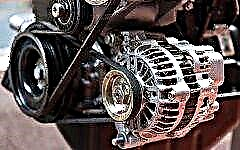
There is a generator in the device of each car. This device converts mechanical energy from external sources into electrical energy, providing recharging of the battery. In the event of equipment malfunction, the battery will quickly discharge or fail. If you check the generator yourself and find the cause of the breakdown, you do not need to go to a car repair shop for a comprehensive diagnosis of the machine.
Causes of generator malfunctions

Since a generator breakdown is almost always accompanied by identical consequences, it is impossible to immediately identify the cause without a deep check. Most often, the problem arises against the background of such factors:
- Seized bearings. The problem is considered to be quite common and is accompanied by the inability of the stem to rotate. During the operation of the vehicle, the moving parts under the hood are subjected to increased loads. This leads to the disappearance of lubrication and partial or complete seizure of important components. And since the bearings have a high density, the belt, which ensures their rotation, can break under the influence of the frictional force. If the belt is damaged, you will have to replace or recycle the generator.
- Burnout of the winding. The problem is provoked by contact with chemicals or salts that are used to treat the road surface in winter. Burned-out wiring loses its integrity and stops generating electric current.
- Sticking or failure of brushes. The malfunction occurs when the graphite rods are worn. They stand out for their limited lifespan and require periodic replacement. But many drivers often forget about this, which leads to generator malfunctions.
- Damage to the regulator relay. The node is designed to prevent overcharging the battery and maintain optimal voltage.
Features of check without removal

Knowing how to check the generator without removing it from the car, you can avoid unnecessary costs or failure of other important components. For error-free verification, the following requirements should be taken into account:
- Diagnostics is carried out using a multimeter.
- When checking valves, the voltage should not exceed 12 V.
- If you have to change the wiring, you need to prepare cables with the same diameter.
- Before checking the generator, it is worth evaluating the correct connection of the fasteners and the reliability of the belt tension.
The key condition for self-diagnostics is to maintain the operability of the device. It is strictly forbidden to do the following:
- Diagnose the generator by means of a short circuit (or a "spark"). This approach can provoke burnout of the part.
- Align terminals with different parameters with each other or connect terminal 30 or B + to ground.
- Check and start the generator without connecting consumers.
Basic methods of checking without removing

Motorists use 2 methods to diagnose the generator without removing it from the car. The first is the oldest, but proven and effective, while the second provides a deeper and finer check with the identification of minor flaws.
If the ancient method is used, then it yields one of two results:
- The device is completely serviceable.
- The generator is malfunctioning.
The popularity of the option is due to the ease of implementation at home. It is enough for the car owner to start the engine and activate the dipped beam.
It is necessary to dismantle the "minus" terminal from the working motor. If the lighting fixtures are functioning normally, and the power plant maintains a normal stroke, then the unit is in good order. In case of unsteady engine operation or jumps in the brightness of the headlights, it will be necessary to carry out a deeper diagnosis, since the device may be in a malfunctioning state.
The next method involves using a multimeter. Specialized equipment detects even minor breakdowns that cannot be found by visual inspection or the use of the first technology.
There are several optimal indicators for any type of vehicle. In the unloaded state, the battery maintains a voltage of 12.5-12.7 V. If the engine is started, the value rises to 13.8-14.8 V. When the maximum level is reached, the mark drops to 13.8. If there is no such reaction, you will need to check the generator.
And since not every driver can ring the unit without errors, then if problems are found, it is better to immediately take the car to a car repair shop, where professional diagnostics will be performed. In this case, specialists will be able to quickly and efficiently check the car and point out the reasons for the breakdown.
To check the voltage regulator, you need to do the following:
- Using a voltmeter with a scale from 0 to 15 V, it is worth checking a well-warmed engine. To do this, the vehicle is started for 15 minutes with the headlights on.
- Diagnostics is carried out between the ground terminal and terminal 30. Finding the normal indicator for most vehicles is quite simple, because it varies in the range of 13.5-14.6 V. When the mark drops below 13 V, the part will have to be replaced.
The next method involves diagnosing the diode bridge of the generator unit. To check, you need to get access to the battery and the device. The voltmeter is connected to ground and the B + terminal on the battery, and after starting the equipment, the display should show 0.5 mA. If it is above this mark, the diodes have been damaged or the winding has been depressurized.
You can also check the recoil current when the power unit is running. The method is quite difficult to use and requires some skill. However, this is justified by the maximum accuracy and the ability to see minor breakdowns.
In the process of diagnostics, the motor starts and accelerates to maximum speed. Next, a probe is attached to the wire, which is directed to terminal 30 or B +.
The electrical devices of the car are turned on one by one, and the information from the multimeter is recorded. After receiving the results, the numbers must be added, and then all electricity consumers must be activated and the data compared with previous indicators.
To check the excitation current of the generator, start the engine at high speed and connect a multimeter to terminal 67. The device will display the exact value and parameters of the excitation current. A working generator shows a mark of 3-7A.
To check the winding, you can perform a visual inspection or use special devices. This manipulation involves a series of preparatory actions:
- removal of the brush holder.
- dismantling the voltage regulator.
- cleaning slip rings.
- assessment of the winding for defects.
After completing the preparation, you should prepare an ohmmeter. The probes of the device are connected to the slip rings and the stator, and then diagnostics are performed. The normal level is 5-10 ohms.
Methods for checking a removed generator

As you know, a generator is a small power plant that supplies power to all standard vehicle devices and systems. If the unit fails, it must be repaired or replaced immediately, since the operation of the vehicle will become impossible.
The following signs indicate generator malfunctions:
- Continuous burning of the signal icon in the form of a red battery on the instrument panel. Such a phenomenon indicates a lack of response from the generator or the presence of insufficient amperage.
- Continuous discharge of the battery.
- Malfunctions of electrical equipment (lighting fixtures, alarms).
- Problems in the multimedia system, climate control or ventilation while the engine is running.
- An unpleasant burning smell in the passenger compartment or engine compartment.
- Overheating of the generator stator.
If such signs are found, a comprehensive diagnosis of the part should be performed to avoid accompanying problems. Checking the unit after removing it from the machine is carried out according to similar principles as in assembled form. However, it also has differences.
At the diagnostic stage, the rotor winding should be checked, which is short-circuited by a sudden voltage surge, contact with water or wear of the brushes.
To assess the performance of the removed generator, you need to disassemble it. After removing the rotor, you should find 2 slip rings on its shaft. Next, you should start the multimeter with the activation of the ohmmeter options and connect its probes to the removed rings. A resistance of 2-5 ohms should appear on the indicator.
These marks are optimal for a running rotor. A deviation from the normal level indicates poor contact between the rings. If the value drops to zero, there is a possibility of a turn-to-turn short circuit.
The next step is to check the stator. It is equipped with several windings, which are assessed separately. Before that, you will need to disconnect the wires connecting the diode bridge and the winding leads.
The multimeter is connected to the terminals of each winding, after which a resistance of 0.2 ohms should appear on it. Next, the resistance is measured between the common terminal and the output of each winding. The optimal indicator is 0.3 ohms.
When diagnosing a removed generator, you can determine the wear of the brushes. They cease to cope with their functions against the background of prolonged operation or due to problems that arise when the rotor shaft is skewed. If the brushes show signs of significant wear, and their shape differs from the usual, you will need to completely change them.
The vehicle's alternator is equipped with two bearings. The first is located on the rotor shaft and the second is in the center of the cover. Hum, whistle, or other sounds when the engine is running indicates bearing wear. The accompanying signs include heating of the case.
If you encounter these symptoms, you will need to replace the bearings immediately. If this is not done, the rotor shaft will be skewed or start to jam, with the ensuing consequences.
To check the bearings, you need to remove the alternator belt and turn the shaft by hand. If the part rotates normally without play and jerks, the bearings are good. If there are problems or backlash, you will need to replace them.
Conclusion
The generator is an indispensable component in every vehicle. If it fails, the normal operation of the machine is compromised. However, in modern cars, various digital indicators and aids are provided to signal possible malfunctions of a part.
Usually, any failure is accompanied by the appearance of a "red battery" icon on the dashboard. If it lights up and starts blinking, diagnosis is inevitable.
In addition, the machine can report problems with the generator in the form of a faint glow from all devices. And if, after opening the hood, a belt break is noticed, the check must be performed as soon as possible.
Timely making the right decisions will avoid unjustified costs and expensive repairs of important vehicle components.

|| list |
- Causes of generator malfunctions
- Features of check without removal
- Basic methods of checking without removing
- Methods for checking a removed generator
|| rss | There is a generator in the device of each car. If you check the generator yourself and find the cause of the breakdown, you do not need to go to a car repair shop for a comprehensive diagnosis of the machine.
Causes of generator malfunctions
Since a generator breakdown is almost always accompanied by identical consequences, it is impossible to immediately identify the cause without a deep check. Most often, the problem arises against the background of such factors:
1. Seizure of bearings. If the belt is damaged, you will have to replace or recycle the generator.
2. Burnout of the winding. Burned-out wiring loses its integrity and stops generating electric current.
3. Sticking or failure of brushes. But many drivers often forget about this, which leads to generator malfunctions.
4. Damage to the regulator relay. The node is designed to prevent overcharging the battery and maintain optimal voltage.
Features of check without removal
Knowing how to check the generator without removing it from the car, you can avoid unnecessary costs or failure of other important components. For error-free verification, the following requirements should be taken into account:
1. Diagnostics is carried out using a multimeter.
2. When checking valves, the voltage should not exceed 12 V.
3. If wiring needs to be changed, prepare cables with the same diameter.
4. Before checking the generator, it is worth evaluating the correct connection of the fasteners and the reliability of the belt tension.
The key condition for self-diagnostics is to maintain the operability of the device.
It is strictly forbidden to do the following:
1. Diagnose the generator by means of a short circuit (or "spark"). This approach can provoke burnout of the part.
2. Align terminals with different parameters with each other or connect terminal 30 or B + to ground.
3. Check and start the generator without connecting consumers.
Basic methods of checking without removing
Motorists use 2 methods to diagnose the generator without removing it from the car. The first is the oldest, but proven and effective, while the second provides a deeper and finer check with the identification of minor flaws.
If the ancient method is used, then it yields one of two results:
1. The device is completely serviceable.
2. The generator is malfunctioning.
The popularity of the option is due to the ease of implementation at home. It is enough for the car owner to start the engine and activate the dipped beam.
It is necessary to dismantle the "minus" terminal from the working motor. In case of unsteady engine operation or jumps in the brightness of the headlights, it will be necessary to carry out a deeper diagnosis, since the device may be in a malfunctioning state.
The next method involves using a multimeter. Specialized equipment detects even minor breakdowns that cannot be found by visual inspection or the use of the first technology.
There are several optimal indicators for any type of vehicle. If there is no such reaction, you will need to check the generator.
And since not every driver can ring the unit without errors, then if problems are found, it is better to immediately take the car to a car repair shop, where professional diagnostics will be performed. In this case, specialists will be able to quickly and efficiently check the car and point out the reasons for the breakdown.
To check the voltage regulator, you need to do the following:
1.Using a voltmeter with a scale from 0 to 15 V, it is worth checking a well-warmed engine. To do this, the vehicle is started for 15 minutes with the headlights on.
2. Diagnostics is performed between the ground terminal and terminal 30. When the mark drops below 13 V, the part will have to be replaced.
The next method involves diagnosing the diode bridge of the generator unit. If it is above this mark, the diodes have been damaged or the winding has been depressurized.
You can also check the recoil current when the power unit is running.However, this is justified by the maximum accuracy and the ability to see minor breakdowns.
In the process of diagnostics, the motor starts and accelerates to maximum speed. Next, a probe is attached to the wire, which is directed to terminal 30 or B +.
The electrical devices of the car are turned on one by one, and the information from the multimeter is recorded. After receiving the results, the numbers must be added, and then all electricity consumers must be activated and the data compared with previous indicators.
To check the excitation current of the generator, you need to start the engine at high speeds and connect a multimeter to terminal 67. A working generator shows a mark of 3-7A.
To check the winding, you can perform a visual inspection or use special devices. Such manipulation involves a number of preparatory actions:
removal of the brush holder.
dismantling the voltage regulator.
cleaning slip rings.
assessment of the winding for defects.
After completing the preparation, you should prepare an ohmmeter. The normal level is 5-10 ohms.
Methods for checking a removed generator
As you know, a generator is a small power plant that supplies power to all standard vehicle devices and systems. If the unit fails, it must be repaired or replaced immediately, since the operation of the vehicle will become impossible.
The following signs indicate generator malfunctions:
1. Continuous burning of the signal icon in the form of a red battery on the instrument panel. Such a phenomenon indicates a lack of response from the generator or the presence of insufficient amperage.
2. Permanent battery discharge.
3. Malfunctions of electrical equipment (lighting devices, alarms).
4. Malfunctions in the multimedia system, climate control or ventilation when the engine is running.
5. The appearance of an unpleasant burning smell in the passenger compartment or engine compartment.
6. Overheating of the generator stator.
If such signs are found, a comprehensive diagnosis of the part should be performed to avoid accompanying problems. However, it also has differences.
At the diagnostic stage, the rotor winding should be checked, which is short-circuited by a sudden voltage surge, contact with water or wear of the brushes.
To assess the performance of the removed generator, you need to disassemble it. A resistance of 2-5 ohms should appear on the indicator.
These marks are optimal for a running rotor. If the value drops to zero, there is a possibility of a turn-to-turn short circuit.
The next step is to check the stator. Before that, you will need to disconnect the wires connecting the diode bridge and the winding leads.
The multimeter is connected to the terminals of each winding, after which a resistance of 0.2 ohms should appear on it. The optimal indicator is 0.3 ohms.
When diagnosing a removed generator, you can determine the wear of the brushes. If the brushes show signs of significant wear, and their shape differs from the usual, you will need to completely change them.
The vehicle's alternator is equipped with two bearings. The accompanying signs include heating of the case.
If you encounter these symptoms, you will need to replace the bearings immediately. If this is not done, the rotor shaft will be skewed or start to jam, with the ensuing consequences.
To check the bearings, you need to remove the alternator belt and turn the shaft by hand. If there are problems or backlash, you will need to replace them.
Conclusion
The generator is an indispensable component in every vehicle. However, in modern cars, various digital indicators and aids are provided to signal possible malfunctions of a part.
Usually, any failure is accompanied by the appearance of a "red battery" icon on the dashboard. If it lights up and starts blinking, diagnosis is inevitable.
In addition, the machine can report problems with the generator in the form of a faint glow from all devices. And if, after opening the hood, a belt break is noticed, the check must be performed as soon as possible.
Timely making the right decisions will avoid unjustified costs and expensive repairs of important vehicle components.











